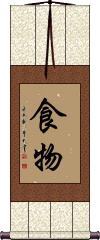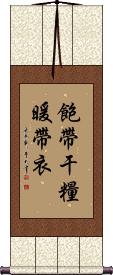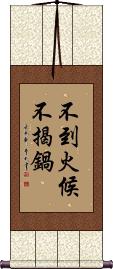Many custom options...
And formats...

Food in Chinese / Japanese...
Buy a Food calligraphy wall scroll here!
Personalize your custom “Food” project by clicking the button next to your favorite “Food” title below...
Food
食物 means food in Chinese, Japanese Kanji, and old Korean Hanja.
This can also be translated as edibles, foodstuffs, nourishment, or sustenance.
Men Die for Wealth, Birds Die for Food
人為財死鳥為食亡 is a Chinese proverb that literally states that human beings will die for riches, just as birds will for food.
Figuratively it means that man will do anything in his means to become rich. Personally, I think dying for food is a more noble cause.
Often translated as “Men die in pursuit of wealth, birds die in pursuit of food. The 人 in this proverb just means human, so “men” is a placeholder for human with that translation - an English language problem that we have no easy gender-neutral nouns.
This proverb is meant to serve as a warning about the follies of greed.
Always Be Prepared
Sumptuous Debauchery
酒池肉林 is a Chinese idiom that is also somewhat known in Japanese and Korean.
This literally means “lakes of wine and forests of meat.”
Figuratively, it refers to debauchery, sumptuous entertainment, a sumptuous feast, or any kind of ridiculously-lavish spread of food and wine.
Do not take action until the time is right
These search terms might be related to Food:
Not the results for food that you were looking for?
Below are some entries from our dictionary that may match your food search...
| Characters If shown, 2nd row is Simp. Chinese |
Pronunciation Romanization |
Simple Dictionary Definition |
乾 干 see styles |
gān gan1 kan nukui ぬくい |
More info & calligraphy: Qianqian (one of the trigrams of the I Ching: heaven, northwest); (surname) Nukui Dry, dried up, clean; heaven, male, masculine, enduring, continual. Translit. gan and h. |
牛 see styles |
niú niu2 niu nyuu / nyu にゅう |
More info & calligraphy: Ox / Bull / Cow(1) cattle (Bos taurus); cow; bull; ox; calf; (2) {food} (usu. ぎゅう) (See 牛肉) beef; (3) (ぎゅう only) {astron} (See 二十八宿,玄武・げんぶ・2) Chinese "Ox" constellation (one of the 28 mansions); (surname) Nyū go, gaus; ox, bull, bullock, etc. A term applied to the Buddha Gautama as in 牛王 king of bulls, possibly because of the derivation of his name; the phrase 騎牛來牛 (or 騎牛覔牛) to ride an ox, to seek an ox, means to use the Buddha to find the Buddha. |
玉 see styles |
yù yu4 yü hikaru ひかる |
More info & calligraphy: Jade(1) (also formerly read as ごく) precious stone (esp. jade); (2) {food} (occ. ギョク) egg (esp. as a sushi topping); (3) stock or security being traded; product being bought or sold; (4) (See 建玉) position (in finance, the amount of a security either owned or owed by an investor or dealer); (5) geisha; (6) (abbreviation) (See 玉代) time charge for a geisha; (7) (abbreviation) {shogi} (See 玉将) king (of the junior player); (female given name) Hikaru Jade, a gem; jade-like, precious; you, your. |
瓊 琼 see styles |
qióng qiong2 ch`iung chiung kei / ke けい |
More info & calligraphy: Joan(personal name) Kei |
紐 纽 see styles |
niǔ niu3 niu himo(p); himo ひも(P); ヒモ |
More info & calligraphy: Neu(1) (kana only) string; cord; (2) (kana only) leash; (3) (kana only) (colloquialism) (esp. ヒモ) man who is financially dependent on a woman; gigolo; pimp; (4) (kana only) restrictions; conditions; (5) (kana only) mantle (shellfish, etc.); (6) (kana only) {food} small intestine (beef, pork); oviduct meat (chicken) |
辛 see styles |
xīn xin1 hsin shinkou / shinko しんこう |
More info & calligraphy: Sim(counter) (colloquialism) counter for spiciness of food (e.g. curry); (surname) Shinkou sharp |
鬆 松 see styles |
sōng song1 sung su す |
loose; to loosen; to relax; floss (dry, fluffy food product made from shredded, seasoned meat or fish, used as a topping or filling) (1) (kana only) cavity (in old root vegetables, tofu, metal casting, etc.); pore; hollow; bubble; blowhole; (can be adjective with の) (2) (kana only) porous; pithy; spongy |
はい see styles |
pai パイ |
(1) {food} pie; tart; (2) {food} (See パルミエ) palmier (pastry); (female given name) Pai; Pye |
亨氏 see styles |
hēng shì heng1 shi4 heng shih |
More info & calligraphy: Heinz |
供養 供养 see styles |
gòng yǎng gong4 yang3 kung yang kuyou / kuyo くよう |
More info & calligraphy: Offering / Puja(noun, transitive verb) memorial service for the dead; holding a service To make offerings of whatever nourishes, e. g. food, goods, incense, lamps, scriptures, the doctrine, etc., any offering for body or mind. |
十戒 see styles |
shí jiè shi2 jie4 shih chieh jukkai じゅっかい |
More info & calligraphy: Ten Commandments(1) (Buddhist term) the 10 precepts; (2) Ten Commandments; Decalogue; Decalog; (surname) Jukkai Śikṣāpada. The ten prohibitions (in Pāli form) consist of five commandments for the layman: (1) not to destroy life 不殺生 pāṇātipātāveramaṇi; (2) not to steal 不倫盜 adinnādānāver; (3) not to commit adultery 不婬慾 abrahmacaryaver.; (4) not to lie 不妄語musāvādāver.; (5) not to take intoxicating liquor 不飮酒 suramereyya-majjapamādaṭṭhānāver. Eight special commandments for laymen consist of the preceding five plus: (6) not to eat food out of regulated hours 不非時食 vikāla-bhojanāver.; (7) not to use garlands or perfumes 不著華鬘好香塗身 mālā- gandha-vilepana-dhāraṇa-maṇḍana-vibhūṣanaṭṭhānā; (8) not to sleep on high or broad beds (chastity) 不坐高廣大牀 uccāsayanā-mahāsayanā. The ten commandments for the monk are the preceding eight plus: (9) not to take part in singing, dancing, musical or theatrical performances, not to see or listen to such 不歌舞倡伎不往觀聽 nacca-gīta-vādita-visūkadassanāver.; (10) to refrain from acquiring uncoined or coined gold, or silver, or jewels 不得捉錢金銀寶物 jātarūpa-rajata-paṭīggahaṇāver. Under the Māhayāna these ten commands for the monk were changed, to accord with the new environment of the monk, to the following: not to kill, not to steal, to avoid all unchastity, not to lie, not to slander, not to insult, not to chatter, not to covet, not to give way to anger, to harbour no scepticism. |
寿司 see styles |
hisashi ひさし |
More info & calligraphy: Sushi |
布施 see styles |
bù shī bu4 shi1 pu shih fuho ふほ |
More info & calligraphy: Dana: Almsgiving and Generosity(n,vs,vi) (1) {Buddh} alms-giving; charity; (n,vs,vi) (2) {Buddh} offerings (usu. money) to a priest (for reading sutras, etc.); (surname) Fuho dāna 檀那; the sixth pāramitā, almsgiving, i. e. of goods, or the doctrine, with resultant benefits now and also hereafter in the forms of reincarnation, as neglect or refusal will produce the opposite consequences. The 二種布施 two kinds of dāna are the pure, or unsullied charity, which looks for no reward here but only hereafter; and the sullied almsgiving whose object is personal benefit. The three kinds of dāna are goods, the doctrine, and courage, or fearlessness. The four kinds are pens to write the sutras, ink, the sutras themselves, and preaching. The five kinds are giving to those who have come from a distance, those who are going to a distance, the sick, the hungry, those wise in the doctrine. The seven kinds are giving to visitors, travellers, the sick, their nurses, monasteries, endowments for the sustenance of monks or nuns, and clothing and food according to season. The eight kinds are giving to those who come for aid, giving for fear (of evil), return for kindness received, anticipating gifts in return, continuing the parental example of giving, giving in hope of rebirth in a particular heaven, in hope of an honoured name, for the adornment of the heart and life. 倶舍論 18. |
接待 see styles |
jiē dài jie1 dai4 chieh tai setsutai せつたい |
More info & calligraphy: Settai(noun/participle) (1) reception; welcome; serving (food term); (2) wining and dining; business entertainment; corporate entertainment; entertaining politicians; (surname) Setsutai To receive and treat, or wait upon. |
春雨 see styles |
chūn yǔ chun1 yu3 ch`un yü chun yü harusame はるさめ |
More info & calligraphy: Harusame / Spring Rain(1) gentle spring rain; (2) (はるさめ only) {food} glass noodles; cellophane noodles; thin noodles made from bean starch (or potato starch); (female given name) Harusame |
食物 see styles |
shí wù shi2 wu4 shih wu shokumotsu しょくもつ |
More info & calligraphy: Foodfood; foodstuff to eat things |
キロス see styles |
kirosu キロス |
{food} gyros (gre:); gyro; (personal name) Quiros |
さがり see styles |
zakari ザカリ |
(food term) hanging tender; thick skirt; (personal name) Zachary |
サント see styles |
zanto ザント |
More info & calligraphy: Santo |
しゃり see styles |
jari ジャリ |
(food term) sushi rice; rice seasoned with vinegar, sugar and salt; (place-name) Zary (Poland); Jarry |
ふおん see styles |
fon フォン |
{food} fond (fre:); (soup) stock; (personal name) Fons |
フライ see styles |
purai プライ |
More info & calligraphy: Fry |
マック see styles |
makku マック |
More info & calligraphy: Mak |
ムース see styles |
muuzu / muzu ムーズ |
More info & calligraphy: Moose |
レバー see styles |
rebaa / reba レバー |
More info & calligraphy: Reber |
サイミン see styles |
saimin サイミン |
More info & calligraphy: Saimin |
サンプル see styles |
sanpuru サンプル |
More info & calligraphy: Sample |
ストック see styles |
sutokku ストック |
More info & calligraphy: Stock |
ヒーター see styles |
piitaa / pita ピーター |
(1) {food} beater (for eggs, etc.); (2) {music} beater (of a bass drum, triangle, etc.); mallet; (male given name) Peter; Petre |
フレイス see styles |
pureisu / puresu プレイス |
{food} braising; (personal name) Place |
Click here for more food results from our dictionary
The following table may be helpful for those studying Chinese or Japanese...
| Title | Characters | Romaji (Romanized Japanese) | Various forms of Romanized Chinese | |
| Food | 食物 | shoku motsu shokumotsu | shí wù / shi2 wu4 / shi wu / shiwu | shih wu / shihwu |
| Men Die for Wealth, Birds Die for Food | 人為財死鳥為食亡 人为财死鸟为食亡 | rén wèi cái sǐ niǎo wèi shí wáng ren2 wei4 cai2 si3 niao3 wei4 shi2 wang2 ren wei cai si niao wei shi wang | jen wei ts`ai ssu niao wei shih wang jen wei tsai ssu niao wei shih wang |
|
| Always Be Prepared | 飽帶干糧暖帶衣 饱带干粮暖带衣 | bǎo dài gān liáng nuǎn dài yī bao3 dai4 gan1 liang2 nuan3 dai4 yi1 bao dai gan liang nuan dai yi baodaiganliangnuandaiyi | pao tai kan liang nuan tai i paotaikanliangnuantaii |
|
| Sumptuous Debauchery | 酒池肉林 | shu chi niku rin shuchinikurin | jiǔ chí ròu lín jiu3 chi2 rou4 lin2 jiu chi rou lin jiuchiroulin | chiu ch`ih jou lin chiuchihjoulin chiu chih jou lin |
| Do not take action until the time is right | 不到火候不揭鍋 不到火候不揭锅 | bù dào huǒ hou bù jiē guō bu4 dao4 huo3 hou bu4 jie1 guo1 bu dao huo hou bu jie guo budaohuohoubujieguo | pu tao huo hou pu chieh kuo putaohuohoupuchiehkuo |
|
| In some entries above you will see that characters have different versions above and below a line. In these cases, the characters above the line are Traditional Chinese, while the ones below are Simplified Chinese. | ||||
Successful Chinese Character and Japanese Kanji calligraphy searches within the last few hours...








